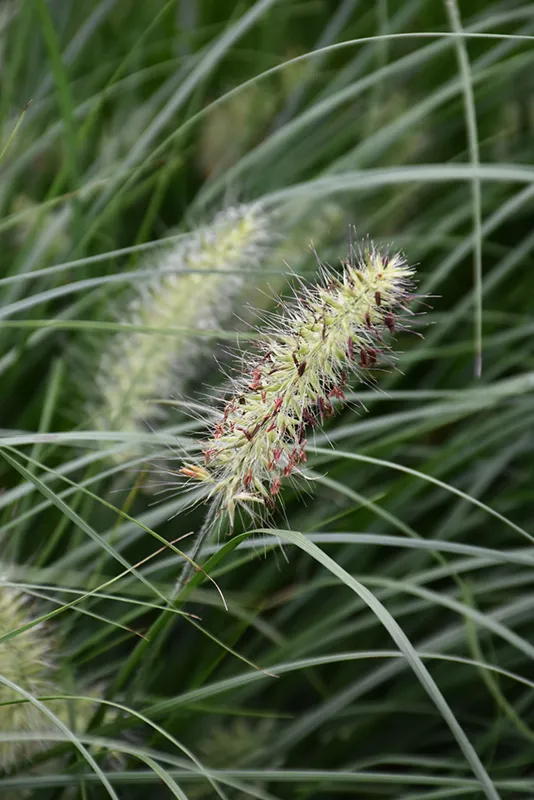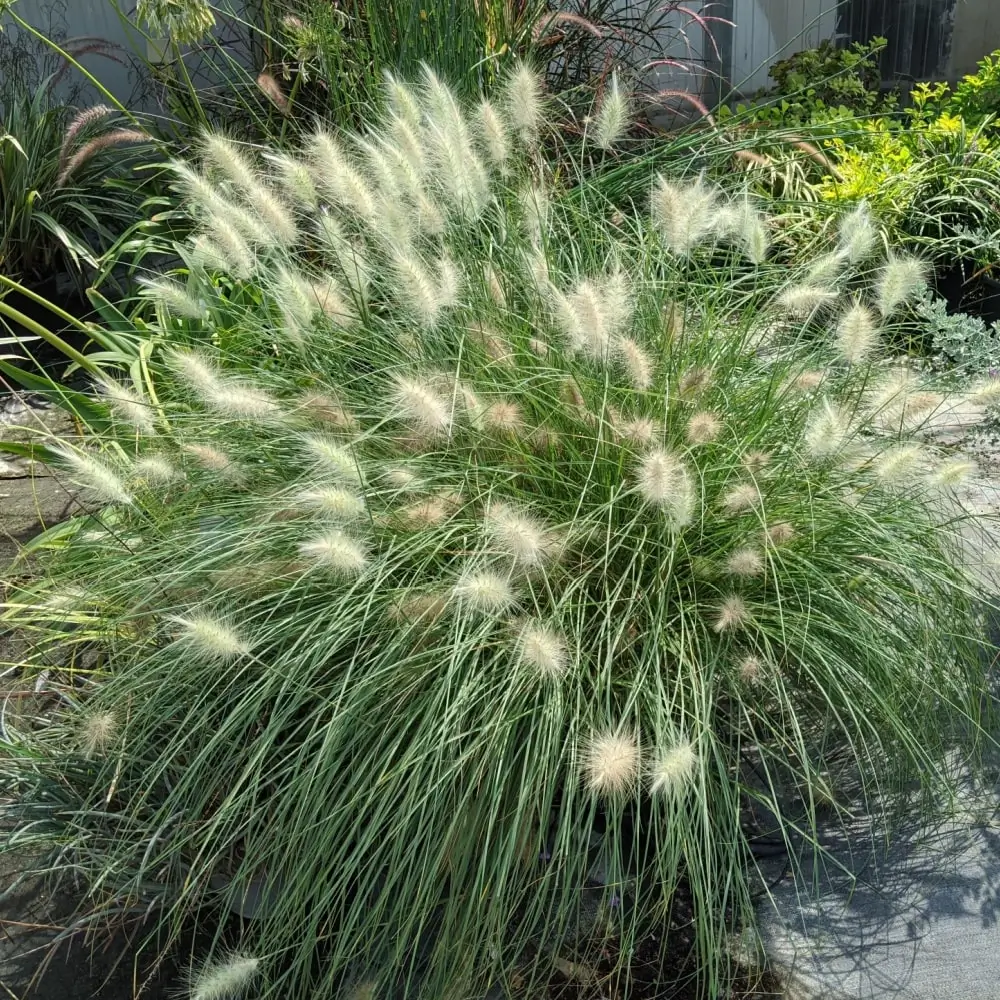Family: Fountain Grass
Type: Ornamental grass

Little Bunny Fountain Grass is the smallest cultivar of the popular Fountain Grasses, making it a delightful addition to any garden space. Known for its fluffy, white, bunny-tail-like plumes, it brings a playful and whimsical element to the landscape.
This dwarf ornamental grass is perfect for small gardens, container gardening, or as an accent in mixed beds. Its compact size and fine-textured foliage make it versatile and easy to incorporate into various garden designs.
Despite its small stature, Little Bunny Fountain Grass is robust and easy to care for. It’s drought-tolerant once established and can thrive in a range of soil conditions, making it a popular choice for gardeners of all levels.
Hardiness Zone: 4b-5a
Deer Resistant: Yes
Pet Friendly: Yes
Moisture Preference: Dry to moist
Sun Needs: Full sun
Drought Tolerance (Xeriscape): Yes
Growth Rate: Medium
Average Height (feet): 1
Average Spread (feet): 1.5
Average Life Span (years): 10
Form: Arching
Flower Color: Yellow
Bloom Season: In mid summer
Foliage Color: Green
Leaf Fall Color: Orange
Foliage Shape: Grassy
Adding Little Bunny Fountain Grass to your landscape introduces texture and movement. Its petite size and charming plumes can soften hard landscaping elements and add depth to garden compositions.
Ideal for edging along borders or pathways, this grass brings a natural, flowing look to these areas. Its fine leaves and fluffy plumes create a soft contrast against hardscaping.
Utilize Little Bunny in rock gardens, as a ground cover, or in container gardens. Its adaptability and small size make it a perfect choice for adding greenery in limited spaces.

Little Bunny Fountain Grass fits perfectly in rock and alpine gardens. Its small size and texture complement the ruggedness of rocks and alpine plants.
For urban balcony gardens, Little Bunny is an excellent choice. It adds a touch of nature without needing much space and thrives in containers.
In cottage gardens, Little Bunny Fountain Grass blends in with a variety of perennials and annuals, adding texture and movement to the informal, lush setting.
Plant Little Bunny in groups for a cohesive, textured ground cover. Its uniform growth habit creates a neat and tidy appearance.
Pair it with colorful annuals or perennials for a dynamic contrast. Its neutral color and fine texture accentuate the vibrancy of flowering plants.
In container gardens, use Little Bunny as a “thriller” or “spiller” element. It adds height or overflows gracefully over the edges, respectively.
Select our pre-made garden layouts to create a landscape that’s uniquely yours. Simple, smart, and customizable!
In spring, Little Bunny Fountain Grass starts to show new growth. Bright green shoots emerge, signaling the start of the growing season.
During summer, this grass is in full bloom. Its adorable plumes resemble fluffy bunny tails, creating a playful and charming garden feature.
In fall, the foliage of Little Bunny may turn golden, blending with autumnal hues. Its plumes may dry out but still provide texture and interest.
In winter, Little Bunny Fountain Grass can offer structural interest in the garden, even as it goes dormant. In milder climates, it may retain some foliage, while in colder regions, it might die back to the ground.
Sedum spectabile 'Autumn Joy'
Perovskia atriplicifolia 'Little Spire'
Buddleia davidii 'Black Knight'
Little Bunny Fountain Grass thrives best in full sun to partial shade. It is ideal for small spaces in gardens, borders, or containers on patios or balconies.
This grass prefers a sunny spot but can tolerate partial shade. Full sun encourages the most vigorous growth and plume production.
Little Bunny is adaptable to a variety of soil types but grows best in well-drained soil. It is tolerant of both slightly acidic and alkaline conditions.
Space plants about 12 to 18 inches apart. This spacing allows for full growth and proper air circulation, which is essential for plant health.
The best time to plant Little Bunny Fountain Grass is in the spring, after the last frost. This timing allows the plant to establish itself before the hot summer months.
Dig a hole as deep and twice as wide as the root ball. Place the plant in the hole, fill it with soil, and water it well to establish.
Water regularly during the first growing season to establish a deep, extensive root system. Once established, Little Bunny is drought-tolerant and requires less frequent watering.
Fertilize lightly in the spring with a balanced, slow-release fertilizer. Over-fertilization can lead to excessive growth at the expense of plumes.
Prune back the grass in late winter or early spring before new growth starts. This helps maintain its shape and promotes healthier growth.
Remove any dead foliage from the previous season and begin regular watering as new growth appears. This is also the best time to apply fertilizer.
Little Bunny requires minimal care in summer. Water during extended periods of dry weather to maintain health and vigor.
Reduce watering as the plant begins to go dormant. Prepare the plant for winter by cutting back on care.
Little Bunny Fountain Grass typically requires little care in winter. In colder climates, it may die back and can be pruned in preparation for spring.
Miscanthus sinensis Gracillimus
Pennisetum alopecuroides 'Hameln'
Pennisetum setaceum 'Fireworks'
Little Bunny Fountain Grass typically grows to about 12-18 inches tall and wide, making it perfect for small garden spaces and containers.
No, Little Bunny is a well-behaved grass and is not considered invasive. It’s a great choice for controlled garden environments.
Absolutely, Little Bunny Fountain Grass is excellent for container gardening. Its small size and attractive foliage make it a perfect choice for adding texture and interest to patio and balcony plantings.
Sign up below to get exclusive deals, discounts, and new plant collections—delivered straight to your inbox! Plus, stay inspired with the latest gardening tips, landscaping trends, and DIY garden ideas. Start growing with us today!
A big thank you for subscribing to the PBN Design newsletter.
We're thrilled to have you join our community. Get ready for exciting updates, insightful content, and more delivered straight to your inbox.
Stay tuned!
Go backA big thank you for subscribing to the PBN Design newsletter.
We're thrilled to have you join our community. Get ready for exciting updates, insightful content, and more delivered straight to your inbox.
Stay tuned!
Go back